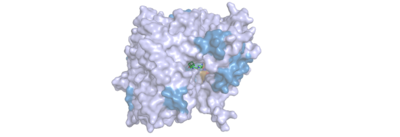User:Karisma Moll/Sandbox 1
From Proteopedia
(Difference between revisions)
| Line 7: | Line 7: | ||
[https://www.sciencedirect.com/science/article/pii/S0304416520301483#t0005 Proline Peptidase Overview] | [https://www.sciencedirect.com/science/article/pii/S0304416520301483#t0005 Proline Peptidase Overview] | ||
=== History === | === History === | ||
| - | Dipeptidyl Peptidase IV's role in the inactivation of incretin hormones | + | Dipeptidyl Peptidase IV's role in the inactivation of [https://en.wikipedia.org/wiki/Incretin incretin hormones] was discovered in the 1990s. Animal studies were conducted in the late 1990s, followed by human studies in the early 2000s. The first DPPIV inhibitors (sitagliptin, vildagliptin, alogliptin, saxagliptin, and linagliptin) were approved starting in 2006, and now serve as monotherapy or add-on to other therapies in a glucose-lowering capacity. <ref name="Ahrén">PMID:31275243</ref> |
=== Function === | === Function === | ||
town tartness | town tartness | ||
| Line 19: | Line 19: | ||
=== Mechanism === | === Mechanism === | ||
The picture of the mechanism is inserted but not visible, maybe too high of a quality? | The picture of the mechanism is inserted but not visible, maybe too high of a quality? | ||
| - | Once a substrate is bound in the active site, DPPIV utilizes a covalent catalysis | + | Once a substrate is bound in the active site, DPPIV utilizes a [https://en.wikipedia.org/wiki/Enzyme_catalysis#Covalent_catalysis covalent catalysis] mechanism to cleave the substrate at the penultimate position. Asp708 of the catalytic triad (MAKE SCENE) (Ser630, His 740, Asp708) pulls electron density from His740 allowing the histidine to pull electron density from Ser630, making serine a stronger nucleophile. The water molecule attacks the carbonyl carbon, breaking the newly formed covalent bo9nd, and releasing the first two residues of the starting substrate. The active site resets. |
[[Image:mech_dppiv.png|500 px|right|thumb|Figure 5. Mechanism of the catalytic triad of DPPIV.]] | [[Image:mech_dppiv.png|500 px|right|thumb|Figure 5. Mechanism of the catalytic triad of DPPIV.]] | ||
=== Inhibitors === | === Inhibitors === | ||
Revision as of 14:40, 26 March 2024
DPPIV in Humans
| |||||||||||
References
- ↑ Ahrén B. DPP-4 Inhibition and the Path to Clinical Proof. Front Endocrinol (Lausanne). 2019 Jun 19;10:376. PMID:31275243 doi:10.3389/fendo.2019.00376
- ↑ 2.0 2.1 Hiramatsu H, Kyono K, Higashiyama Y, Fukushima C, Shima H, Sugiyama S, Inaka K, Yamamoto A, Shimizu R. The structure and function of human dipeptidyl peptidase IV, possessing a unique eight-bladed beta-propeller fold. Biochem Biophys Res Commun. 2003 Mar 21;302(4):849-54. PMID:12646248
Student Contributors
- Karisma Moll
- Merritt Jugo
- Sam Magnabosco

